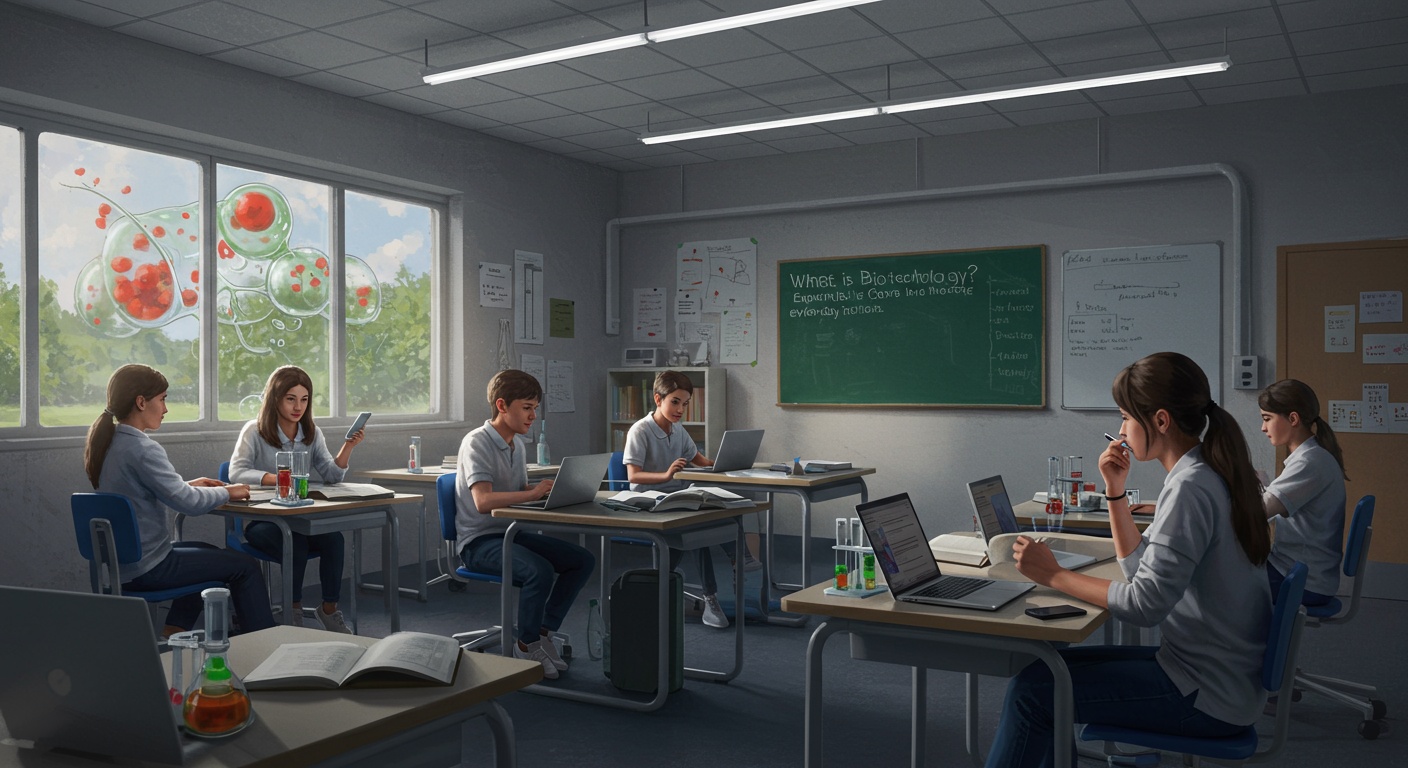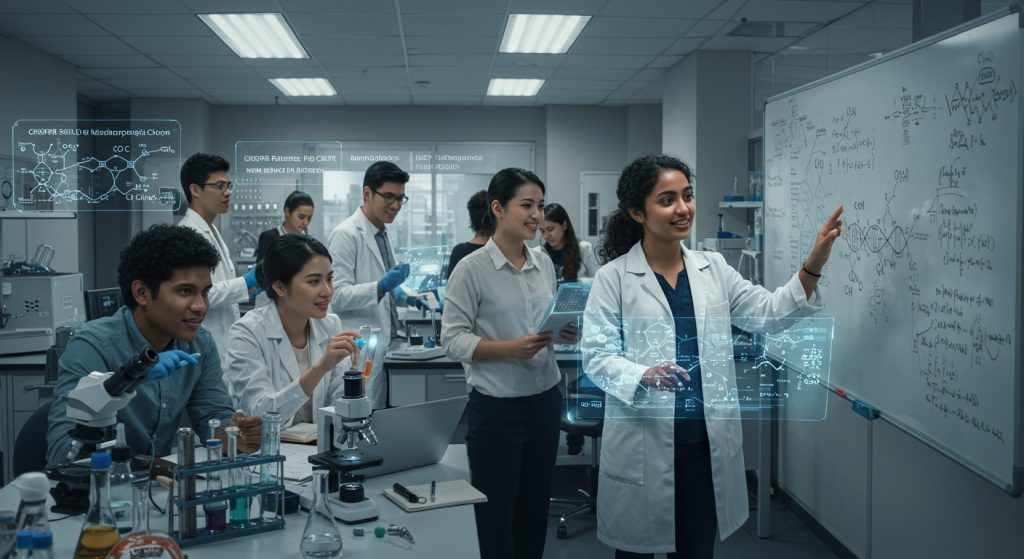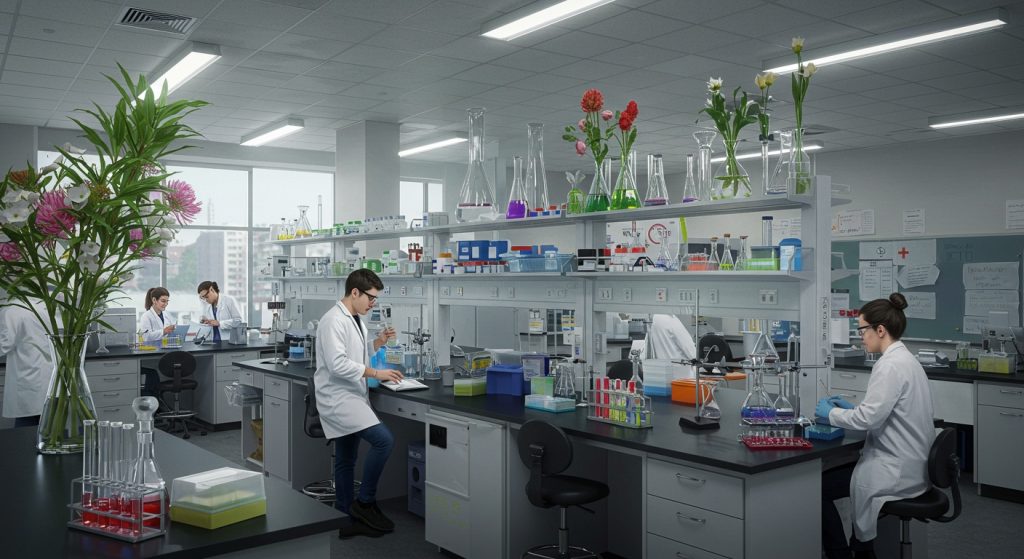Biotechnology, at its core, defines the innovative use of living organisms or their components to develop products and processes for human benefit. From ancient fermentation to modern genetic engineering, this dynamic field continually reshapes our world. Recent breakthroughs in CRISPR gene editing, enabling precise DNA modifications, exemplify its power, while the rapid development of mRNA vaccines against global pandemics showcases its critical role in health. Beyond medicine, biotechnology drives sustainable solutions like bio-based plastics and cultivates novel food sources, such as lab-grown meat, addressing environmental challenges and food security. Understanding this evolving discipline reveals how biological insights translate into tangible, transformative applications across diverse industries.

Understanding the Core: What is Biotechnology Definition?
At its heart, understanding what is biotechnology definition is key to grasping this transformative field. Simply put, biotechnology is the application of biological organisms, systems, or processes to develop or create products and technologies that improve our lives and the health of the planet. It’s an interdisciplinary field that marries biology with technology, leveraging living systems and their components to solve challenges in diverse sectors like medicine, agriculture. Industry.
Think of it as using nature’s own tools – from microscopic bacteria to complex plant cells – and enhancing them with human ingenuity. This isn’t a new concept; humanity has been practicing rudimentary forms of biotechnology for thousands of years, such as brewing beer or making cheese through fermentation. What’s new is the precision and power we now wield, thanks to breakthroughs in genetics, molecular biology. Computing, allowing us to manipulate life at its most fundamental level.
The Foundational Pillars: Core Concepts of Biotechnology
Biotechnology stands on several core scientific principles and techniques. Understanding these is crucial to appreciating the breadth of its applications:
- Genetic Engineering (Recombinant DNA Technology)
- Cell Culture
- Fermentation
- Bioinformatics
- Enzymology
This is perhaps the most revolutionary aspect. It involves the direct manipulation of an organism’s genes. Scientists can cut, paste. Insert specific DNA sequences from one organism into another, giving the recipient new traits. For instance, the ability to produce human insulin in bacteria, a breakthrough that revolutionized diabetes treatment, is a direct result of recombinant DNA technology.
This technique involves growing cells outside their natural environment, typically in a controlled laboratory setting. It’s fundamental for producing vaccines, therapeutic proteins. For studying cell behavior, disease mechanisms. Drug responses without needing to test directly on living organisms.
While ancient, modern biotechnology has refined fermentation processes. This biological process uses microorganisms (like yeast or bacteria) to convert organic substances into simpler compounds, often producing valuable byproducts like alcohol, organic acids, or enzymes. It’s central to antibiotic production, biofuel generation. Even the creation of specific food ingredients.
As biotechnology generates vast amounts of data (e. G. , DNA sequences, protein structures), bioinformatics provides the computational tools and techniques to store, review. Interpret this complex biological insights. It’s the bridge between biology and computer science, essential for drug discovery, personalized medicine. Understanding evolutionary relationships.
Enzymes are biological catalysts that speed up chemical reactions. Biotechnology harnesses these powerful molecules for various industrial processes, from breaking down starches in food production to synthesizing new pharmaceutical compounds.
The Spectrum of Biotechnology: Different Colors, Different Applications
Biotechnology is often categorized by ‘colors’ to denote its primary application areas. While these categories sometimes overlap, they help illustrate the field’s diversity:
| Color | Description | Example Application |
|---|---|---|
| Red Biotechnology | Focuses on medical and pharmaceutical applications. | Development of new vaccines, gene therapies, diagnostic tests. Personalized medicine. Think of the rapid development of mRNA vaccines during the COVID-19 pandemic. |
| Green Biotechnology | Applied to agricultural processes, aiming to improve crop yields, quality. Resistance. | Genetically modified crops (GMOs) resistant to pests or herbicides, biofertilizers. Stress-tolerant plants. For example, ‘Golden Rice’ engineered to produce beta-carotene for Vitamin A deficiency. |
| White Biotechnology | Also known as industrial biotechnology, it uses living organisms or enzymes for industrial production of chemicals, materials. Energy. | Production of biofuels (e. G. , bioethanol), bioplastics, enzymes for detergents. Bio-based industrial chemicals, leading to more sustainable manufacturing processes. |
| Blue Biotechnology | Explores marine and aquatic organisms for new products and applications. | Discovery of novel enzymes, drugs from marine organisms. Biofuels from algae. Potentially new antibiotics or anti-cancer agents from deep-sea microbes. |
| Gold Biotechnology | Relates to bioinformatics and computational biology, using computational tools to review biological data. | Genomic sequencing analysis, protein structure prediction. Drug target identification through large-scale data processing. |
| Grey Biotechnology | Concentrates on environmental applications, such as bioremediation and waste treatment. | Using microorganisms to clean up oil spills (e. G. , after the Deepwater Horizon spill, bacteria were used to degrade oil), treat wastewater, or detect pollutants. |
Unveiling the Tools: Key Technologies Powering Biotechnology
The advancements in biotechnology are fueled by sophisticated tools and techniques that allow scientists to work with biological molecules with unprecedented precision:
- Polymerase Chain Reaction (PCR)
This revolutionary technique, developed by Kary Mullis, allows scientists to make millions or even billions of copies of a specific DNA segment from a very small sample. It’s like a biological copy machine for DNA.
// Simplified concept of PCR steps 1. Denaturation: Heat to separate DNA strands. 2. Annealing: Cool to allow primers to bind to target DNA. 3. Extension: DNA polymerase synthesizes new DNA strands. // Repeat cycles (typically 25-35 times) PCR is indispensable for diagnosing infectious diseases (like COVID-19 testing), forensic analysis. Genetic research.
This technology determines the exact order of nucleotide bases (A, T, C, G) in a DNA molecule. Knowing this sequence is fundamental to understanding genes, identifying mutations. Mapping entire genomes. The Human Genome Project, completed in 2003, was a monumental achievement in DNA sequencing, providing the complete genetic blueprint of a human being.
Often hailed as one of the most significant breakthroughs in biology, CRISPR (Clustered Regularly Interspaced Short Palindromic Repeats) is a powerful gene-editing tool. It allows scientists to precisely cut DNA at specific locations, enabling them to remove, add, or alter genes. This has immense potential for correcting genetic defects, developing new disease models. Engineering organisms with desired traits. For example, researchers are exploring CRISPR to treat genetic disorders like sickle cell anemia and cystic fibrosis.
These are controlled environments, often large vessels, where biological processes occur on an industrial scale. They provide optimal conditions (temperature, pH, oxygen levels) for microorganisms or cells to grow and produce desired products, such as pharmaceuticals, enzymes, or biofuels.
Biotechnology in Action: Everyday Applications Shaping Our World
Biotechnology isn’t just confined to laboratories; its impact is felt in countless aspects of our daily lives:
- In Medicine and Healthcare
- Insulin Production
- Vaccines
- Gene Therapy
- Diagnostics
- Personalized Medicine
- In Agriculture and Food Production
- Genetically Modified Organisms (GMOs)
- Disease-Resistant Crops
- Biofertilizers and Biopesticides
- Food Processing
- In Industry and Environment
- Biofuels
- Bioplastics
- Enzymes in Detergents
- Bioremediation
- Waste Treatment
Before biotechnology, insulin for diabetics was extracted from animal pancreases, often leading to allergic reactions. Today, human insulin is produced by genetically engineered bacteria, a purer, more abundant. Safer source.
Many modern vaccines, including recombinant protein vaccines (like for Hepatitis B) and mRNA vaccines (for COVID-19), are products of biotechnology, offering effective protection against infectious diseases.
This emerging field aims to treat genetic diseases by correcting faulty genes. While still in its early stages, successful trials have been conducted for conditions like severe combined immunodeficiency (SCID) and spinal muscular atrophy (SMA).
Biotechnology provides rapid and accurate diagnostic tests for diseases, from pregnancy tests to tests for HIV, cancer markers. Genetic predispositions.
By analyzing an individual’s genetic makeup, biotechnology allows for tailored drug treatments and dosages, optimizing efficacy and minimizing side effects.
Crops engineered to be resistant to pests (e. G. , Bt corn), herbicides (e. G. , Roundup Ready soybeans), or to have enhanced nutritional value (e. G. , Vitamin A-enriched ‘Golden Rice’). This technology helps feed a growing global population more efficiently.
Biotechnology enables the development of crops that can withstand devastating plant diseases, reducing crop losses and the need for chemical sprays.
Using beneficial microbes to enhance soil fertility or control pests naturally, reducing reliance on synthetic chemicals.
Enzymes produced through biotechnology are widely used in food production, from clarifying fruit juices to improving dough elasticity in baking and producing high-fructose corn syrup.
Production of ethanol from corn or sugarcane. Biodiesel from vegetable oils or algae, offering renewable energy alternatives to fossil fuels.
Developing plastics from renewable biomass sources like corn starch or cellulose, which can be biodegradable, reducing plastic pollution.
Biotechnology produces enzymes that break down stains (proteins, fats, starches) in laundry detergents, allowing for more effective cleaning at lower temperatures.
Using microorganisms to break down environmental pollutants, such as oil spills, industrial waste. Contaminated water, restoring ecosystems naturally.
Biotechnological processes are crucial in municipal and industrial wastewater treatment plants, using microbes to break down organic matter and remove contaminants.
Navigating the Future: Ethics and the Horizon of Biotechnology
As powerful as biotechnology is, its rapid advancement also brings forth significant ethical considerations. Debates surrounding genetically modified organisms, the potential for gene editing in human embryos. The privacy implications of genetic data are crucial conversations that involve scientists, ethicists, policymakers. The public.
But, the future of biotechnology is incredibly promising. We are on the cusp of breakthroughs in:
- Advanced Gene Therapies
- Synthetic Biology
- Precision Fermentation
- AI and Machine Learning Integration
Expanding the range of treatable genetic diseases and potentially curing conditions previously deemed incurable.
Designing and building new biological parts, devices. Systems. Redesigning existing natural biological systems for useful purposes. Imagine ‘designer’ microbes that produce complex medicines or materials.
Using microbes to produce specific proteins and molecules, including alternative proteins for food (e. G. , lab-grown meat components) and high-value chemicals.
Artificial intelligence is accelerating discovery in biotechnology, from predicting protein structures to designing new drugs and optimizing biological processes.
The field of biotechnology is not just about scientific discovery; it’s about reimagining our relationship with the natural world and harnessing its immense potential responsibly to build a healthier, more sustainable future.
Conclusion
We’ve journeyed through the dynamic world of biotechnology, recognizing it as far more than just lab coats and test tubes. From revolutionizing medicine with mRNA vaccines and advanced gene therapies like CRISPR, to shaping sustainable agriculture and producing bio-based materials, its presence is woven into our daily lives. A personal tip: next time you encounter a news story about a groundbreaking drug or an innovative environmental solution, consider the intricate biotech breakthroughs behind it. The field is rapidly evolving; for instance, the integration of AI in drug discovery is accelerating breakthroughs at an unprecedented pace, as seen with novel protein folding predictions. To truly grasp its profound impact, I encourage you to remain intensely curious and actively seek out new developments. Comprehend that biotechnology isn’t a static concept but a continuously expanding frontier with immense potential to address global challenges. Embrace this knowledge, for an informed understanding empowers you to appreciate and contribute to the incredible advancements shaping our future.
More Articles
Governing Chaos: Data Governance Challenges with Uncategorized details in 2025
Financial Flow: How to Effectively Manage Uncategorized Transactions for Clarity
Data Detox: Best Practices for Dealing with Your Uncategorized insights Overload
Data Blind Spots: How Uncategorized data Skews Your BI Dashboards
FAQs
So, what exactly is biotechnology?
Simply put, biotechnology is using living organisms, or parts of them, to create products or processes that benefit us. Think of it as biology combined with technology to solve problems, whether it’s making new medicines, better food, or even cleaning up pollution.
How does biotechnology actually work its magic?
It’s all about understanding and then manipulating biological systems. This could mean altering the genes of a plant to make it pest-resistant, using microbes to create useful chemicals, or even engineering human cells to produce life-saving drugs. It leverages our deep knowledge of DNA, proteins. How cells function.
Can you give me some everyday examples of biotechnology?
Absolutely! It’s in the cheese and yogurt you eat (fermentation), the laundry detergent that cleans your clothes (enzymes), many modern medicines like insulin or vaccines. Even the biofuels in some vehicles. It’s also behind the rapid COVID-19 tests and DNA forensics used in crime solving.
Is biotechnology just about genetically modified organisms (GMOs)?
Not at all! While GMOs are a part of biotechnology, the field is much broader. It includes traditional practices like brewing beer and baking bread, using microbes for waste treatment, developing diagnostic tests for diseases. Even growing tissue for medical research. Genetic engineering is just one tool in the biotech toolbox.
Why is biotechnology considered so vital? What kind of problems does it help solve?
It’s a huge deal because it offers solutions to some of humanity’s biggest challenges. We’re talking about developing new cures for previously untreatable diseases, increasing food production sustainably to feed a growing population, creating cleaner energy sources. Protecting our environment. It aims to improve quality of life across many sectors.
Are there any downsides or ethical concerns to consider with biotechnology?
Like any powerful technology, there are vital considerations. Discussions often revolve around the ethics of genetic editing, potential environmental impacts of genetically modified crops (like effects on biodiversity). Ensuring that these amazing innovations are accessible and affordable for everyone, not just a few. Responsible research and regulation are key.
What does the future hold for biotechnology? What can we expect?
The future looks incredibly exciting! We’re seeing rapid advancements in personalized medicine (tailoring treatments to your unique genetic makeup), gene therapies that could cure inherited diseases, lab-grown meat and sustainable food alternatives. Even using biotech to address climate change by capturing carbon or creating new sustainable materials. It’s a field that’s constantly evolving.



